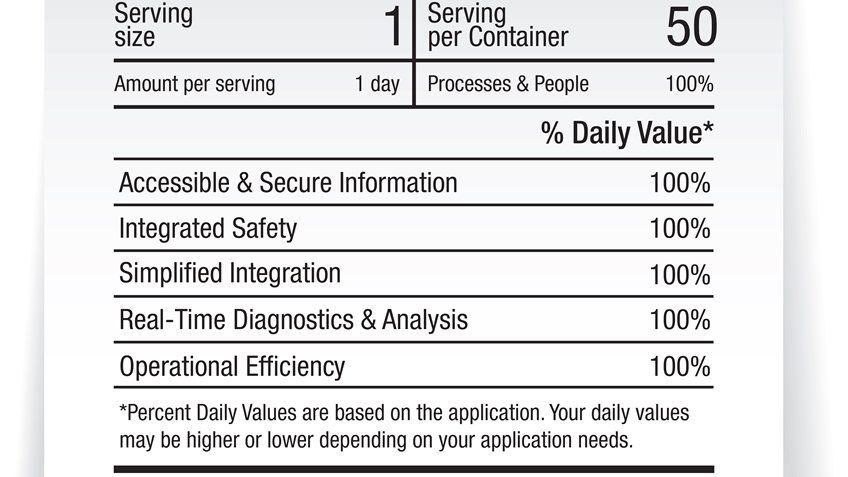By Dan Seger, Principal Application Engineer, Rockwell Automation
Original equipment manufacturers (OEMs) always have been expected to innovate and keep pace with end users' requirements. Yet, today in the era of smart manufacturing, users want to optimize their production and supply chain by bringing together islands of information — and they want OEMs to help. Delivering on the promise of smart manufacturing is vital.
The Connected Enterprise® is at the heart of a smart operation, which consists of converged IT and operations technology (OT) systems into a single network architecture. It also uses smart machines and Industrial Internet of Things (IIoT) technologies for seamless connectivity and information sharing across people, plants and supply chains.
As a result, users need smart machines and equipment designed to thrive in The Connected Enterprise® and provide nearly endless opportunities to improve their operations. It also can help them address their most pressing needs, such as:
- Remaining globally competitive by keeping business models relevant and moving from mass production to mass customization.
- Addressing workforce issues, including retaining the skills of retiring workers, and helping IT and OT workers prepare for the influx of new smart technologies.
- Addressing risks, including security threats and increasingly complex regulations.
- Making the most of Internet- and Ethernet-enabled technologies.
This all may be daunting for industrial OEMs. However, they can meet customers' needs and simplify design of smart systems by focusing on three key elements: processes, technology and people.
Processes: Meet End Users on Their Journey
An end user's journey to The Connected Enterprise® generally follows four stages (see sidebar). Still, every journey will be distinct. Factors such as operational needs, available resources and workforce availability will be unique to each organization and influence their Connected Enterprise path.
OEMs will encounter end users at different points in their journey. Some will be in the early planning stages. Others may be in the midst of IT/OT convergence, and still others may be ready to integrate smart machines or equipment.
It's important for OEMs to communicate with users to understand their needs and stage in the journey. Those conversations also can help OEMs identify opportunities to innovate with their customers, such as using remote monitoring to monitor assets and maximize uptime.
Ultimately, OEMs always must be ready to equip users with smart machines or equipment, regardless of where they are in their journey.
Technology: Deliver Systems That Match Needs
OEMs that want to support smart manufacturing and industrial operations should rethink traditional, machinery-design approaches. As they consider different design aspects to change and update, five key technology areas are important:
1. Integrated Safety. Combining standard and safety control into a single platform enables the use of intelligent, machine-safety-system designs. This can improve productivity while still achieving compliance. Machines also can collect safety-system data to alert operators where safety-related issues are occurring for faster downtime resolutions and long-term improvements.
2. Accessible and Secure Information. End users develop goals for securely accessing and capitalizing on their operational, business and transactional data. OEMs can support and fulfill those goals by connecting control systems and using performance dashboards that make information available and actionable.
3. Simplified Integration. Replacing a multi-tiered networking strategy with a single, open EtherNet/IP™ network can simplify the network infrastructure and reduce integration risks. Likewise, a single, Logix-based control and information platform can ease the collection, transfer and analysis of real-time operations data.
4. Real-Time Diagnostics and Analysis. Embedded-intelligence devices can deliver real-time data for predictive maintenance to help users more quickly troubleshoot and repair problems. Remote monitoring also can monitor critical parameters and address issues before they reach a point of failure.
5. Operational Efficiency. Design tools and scalable automation technology help OEMs deliver flexible equipment for multiple purposes to improve efficiency. For example, modular programming and re-usable code can help reduce system complexity and support faster design, commissioning and installation times. Motion-sizing tools also can help make mechatronic designs faster and easier to analyze, and help optimize, simulate and select motion-control systems.
People: Secure the Right Skills
Engineers and programmers must understand the blend of IT/OT technologies used in connected plants and enterprises. They also must know how to configure, operate and sustain their customers' networked industrial control systems.
Providing training for existing workers can be critical to achieving this, especially because skilled workers are increasingly hard to find. OEMs should consider using training and certification courses developed specifically to help bridge the IT/OT gap in smart operations.
OEMs don't need to go it alone. Look to use vendors' consultative, design, integration and support services to help fill areas of need, such as to help design a more secure control system in a connected operation, help smart machines and equipment comply with the latest standards, or analyze trends and recommend actions to help prevent downtime.
Keeping Up With Expectations
End users still expect machines and equipment to help them optimize processes, achieve compliance, maximize quality and protect workers. But they also now expect those same systems to easily integrate into their operations, offer production intelligence and improve their responsiveness to changing market demands.
With the right mix of processes, technology and people, OEMs can develop smart machines and equipment that meet these higher expectations.
Learn about Rockwell Automation OEM Solutions.
The Journal From Rockwell Automation and Our PartnerNetwork™ is published by Putman Media, Inc.

